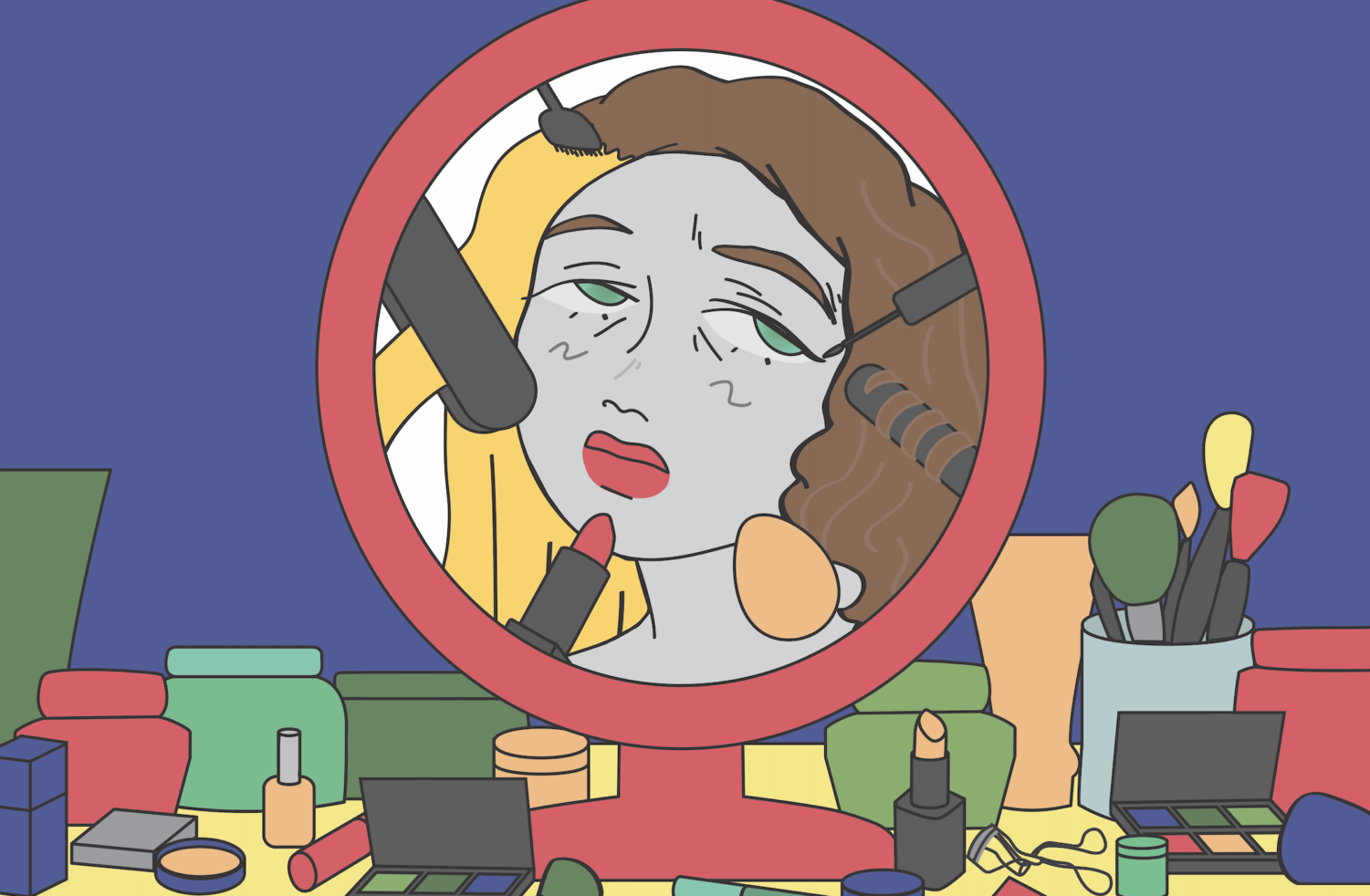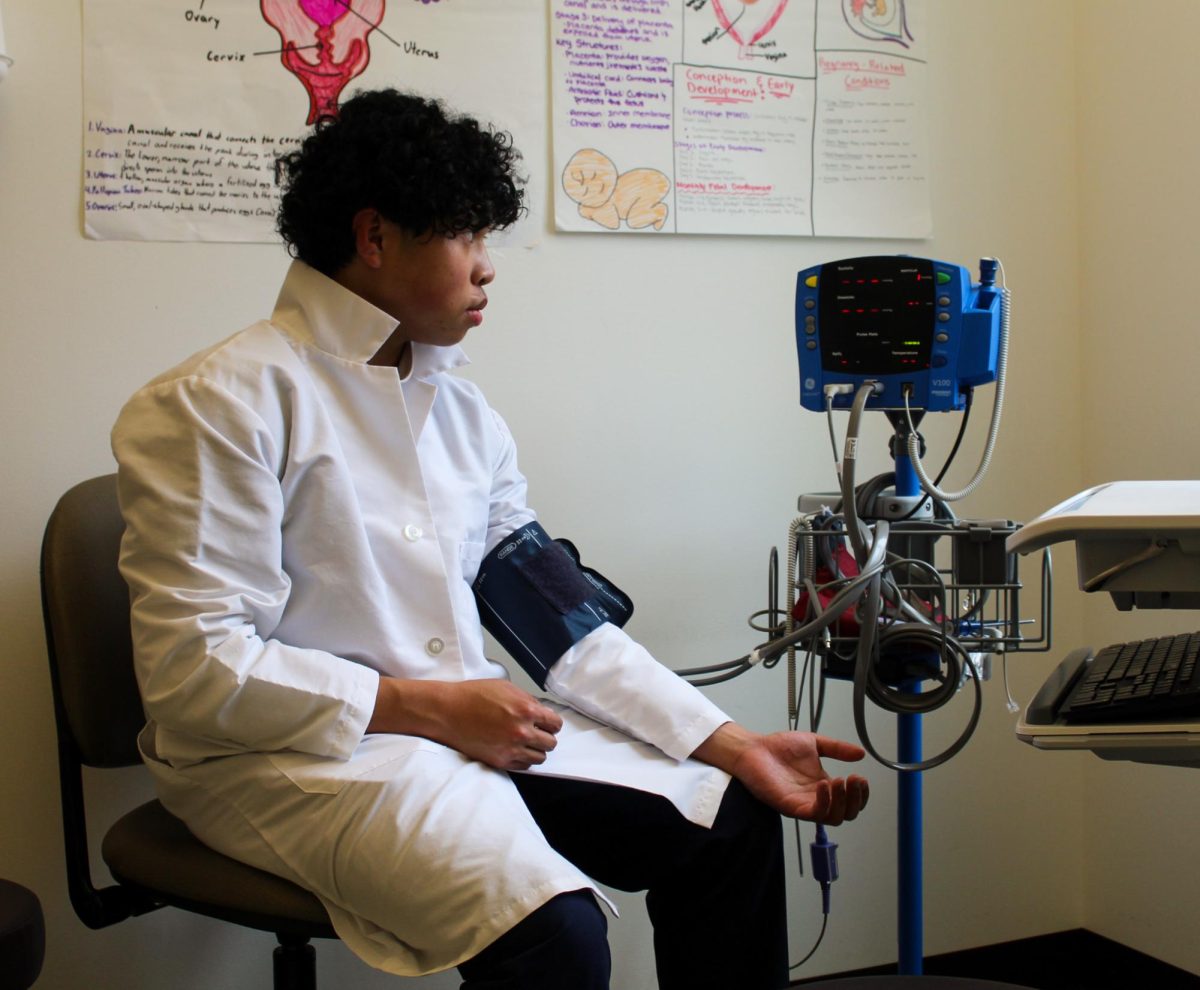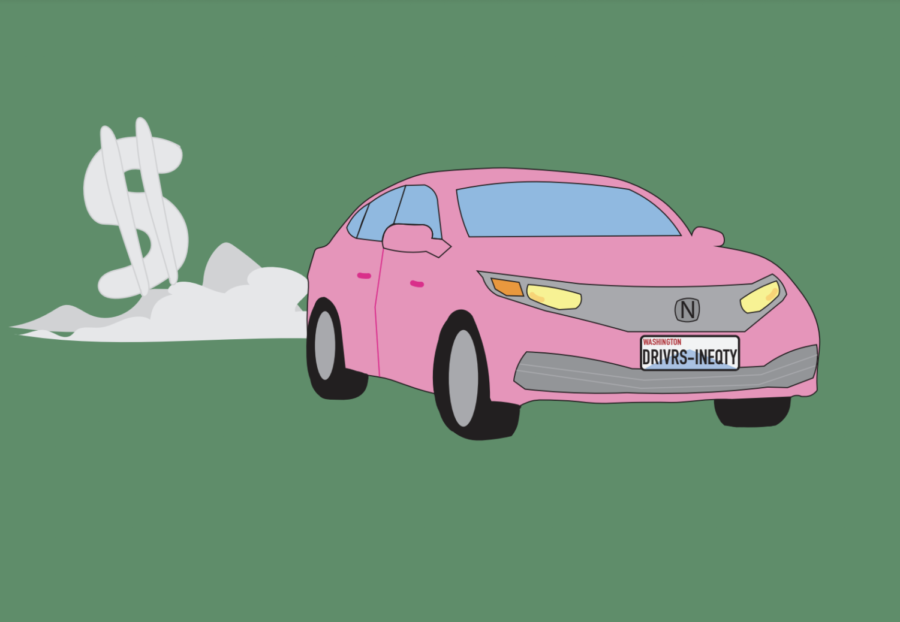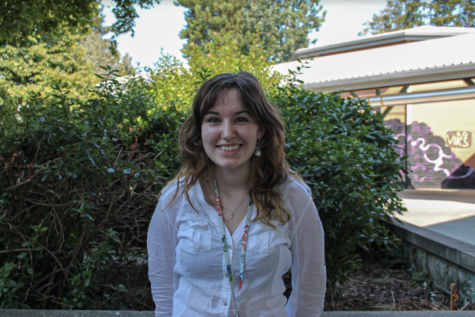Expectations surpassing reality
In a survey of 117 students, 72.7% of Inglemoor students said they use skincare products at least once a day, and 28.2% wear makeup every day. This information follows a similiar trend in the rest of the United States: According to Advanced Dermatology, the average American spends $722 a year on their appearance.
New makeup products are constantly entering the market, and the importance of skincare is growing in the beauty industry. This is supported by the prevalent culture of overconsumption. The usage of beauty products often starts with the pressure to look good. Many teenagers may feel pressure to maintain a certain appearance in high school due to societal expectations and social norms.
Confidence is usually associated with feeling pretty and fitting in with societal expectations. This may mean using and investing in more beauty products. Senior Bella Iwen (she/her) said that skincare and makeup help her feel more confident on a daily basis.
“When I feel confident and good about the way I look, I think it helps me do better in my everyday life. I’m more motivated to be at school. I’m more motivated to talk to people,” said Iwen. “I think it’s a really big thing that a lot of girls my age deal with. Sometimes it can be hard to come to school without makeup on because people are always like, ‘Oh, you look so tired,’ or ‘You don’t look like yourself.’”
Historically, the main demographic that beauty companies target is women. It’s expected for women to look pretty, which can create harmful and unrealistic standards for people to live up to, especially when these expectations can be skewed because of how often bodies and faces are edited in the media.
Advertisements for beauty products almost always feature a beautiful woman showing off the effects of a cosmetic, even with generic products like body lotion. This encourages consumers to buy more products to fit that image, creating a profit cycle for cosmetic companies. Iwen said that pressures to fit in helped contribute to her makeup consumption.
“As I got older, I feel like there became a little bit more pressure to be pretty or fit in. So I think that was another major thing that kind of persuaded me to buy some of the things that I bought when I was in middle school,” said Iwen.
Senior Muntaha Sohail (she/her) sees makeup as an art form, experimenting with vibrant colors and fun styles. She mentioned, however, that other people’s perceptions of her can depend on how her makeup looks that day.
“One time I came into school wearing ducks on my eyes. I put on eyeliner where it was a little water and I had a duck on one side. On the other side I had bubbles. And it was fun. But then I had a teacher telling me that they couldn’t take me seriously,” said Sohail.
A lot of beauty standards are contradictory. With natural makeup, also referred to as “no-makeup makeup,” people are expected to wear cosmetics but appear as though they aren’t. This trend affirms social standards to modify appearance, resulting in insecurities in natural features that others may not deem pretty. People are expected to buy more products regardless of the look they’re going for; whether that be more or less makeup, products are constantly bought.
Although primarily targeting women, in recent years, there’s been a higher expectation for men to meet a specific societal standard of beauty as well. Skincare has become more of a focus among men and non-female-identifying people. Freshman Rhitaj Smoum (any pronouns) said they feel more confident using skincare.
“It’s made me feel a lot better about myself, especially my skin because I used to have really bad skin. But now that I started using beauty products, I feel like it’s much cleaner and I can feel more confident about it,” said Smoum.
Makeup isn’t typically marketed towards men. Sophomore Charlie Haug (he/him) uses cleanser to prevent acne and doesn’t wear makeup. Haug attributes the lack of men who wear makeup to gender stereotypes and an unwillingness to talk about wearing makeup.
“I’ve never really considered wearing makeup, but I feel like if it was more common, I bet you a lot of guys would at least try it,” said Haug.
Effects of social media and influencers
Social media networks are incredibly effective at advertising beauty products, especially TikTok. Hacks, hauls and hashtags like “I want it, I got it,” which boasts over 708 million views, and “Beauty Products,” with more than 1.1 billion views, rapidly propel new products to viral success. In the same Nordic survey, 30% of respondents said that trends influenced which products they chose to buy, and 22.7% cited influencers as a factor. Iwen said that she hears about new products on TikTok, which has a big influence on her.
“If I see a new makeup product or skincare going around on TikTok and everyone’s raving about it, then I’m definitely more likely to buy it,” said Iwen.
Iwen said she’s seen examples of overconsumption from users her age, typically through purchasing large amounts of products, which puts pressure on people to buy the same amount to fit in.
“People will buy really expensive skincare brands, like the whole line of them, and then maybe use them for about two weeks and then buy a new one to test out, to show to social media like flexing all their new products,” said Iwen. “I think that a lot of TikTokers that are idolized nowadays have a lot of money, so they can buy all these new skincare/makeup products that aren’t really realistic for people like me. So I think it puts a lot of pressure for people to feel like they need to have all these things.”
Senior Kiera Freeman (she/her) agreed with Iwen’s sentiments. She has been using makeup and skincare products since around seventh grade and said brand influence and YouTube videos sparked her interest in cosmetics. On these platforms, products get easily hyped, especially beauty products and the market for that product gets super high, Freeman said.
“I find myself definitely spending a lot of money on products that are probably not even that good. They’re just hyped,” said Freeman.
If an influencer advertises a product that turns out to be ineffective, you’re stuck with the product you paid a lot of money for, junior Serena Gustafson (they/them) said. Gustafon has not only witnessed makeup overconsumption online, but also in their own life.
“My cousin just moved houses — they had to size down. She has an entire shelf full, from top to bottom, closet full of makeup. And she actually had to donate about 90% of it just because she had a bunch of the same exact brushes, the same foundations, the same palettes over and over and over that she told me that she used a couple of times and then just put them away because she bought a new one or the newest ones,” said Gustafson.
When buying products, Freeman said she prioritizes how well they react with her skin.
“First, if it causes irritation, I won’t use it. But I also definitely [am influenced] social-wise, like how hyped the product is, how much attention it has, because those products will probably be better.”
In the survey, 57.3% said that ingredients helped determine what products they bought. But despite recommending products to customers, Sohail, a former beauty retail employee, said she did not know much about those products’ ingredients.
“We were taught about the cruelty-free and the vegan stuff and how to identify them for the guests and to show them this is this and this is that. We were not taught anything about the ingredients, though,” said Sohail.
Gustafson said they have sensitive skin and are particular about the products they use. They also said they don’t know what ingredients go into their makeup and skincare.
“So when it comes to skincare products, it’s usually just like, I’ll try it out, see if it works. If it does, then I’ll keep using it. If it doesn’t work, discard it, give it to my siblings,” said Gustafson.
Smoum said he thinks he discovered all his beauty products on social media, and when purchasing a new product, he typically researches ingredients and reviews to see if it’s compatible with his skin.
“I don’t want to waste my money with using a product, with buying a product and then not using it,” said Smoum. “I do feel like I’m wasting a lot of money though. But in some cases, I honestly feel like that waste of money is kind of better at the end for myself.”
Breaking the beauty binge
Due to the difficulty in finding suitable products for individual skin types — whether normal, oily, dry, sensitive or combination — many people may buy excessive amounts of products to see what works for them. On the other hand, some may overstock on the same product if it works well with their skin.
While some simply keep the products that they don’t use, there are also people who return used products to get money back. Sohail said that according to company policy, Ulta retailers must throw away returned products with any sign of use, as selling used products could transmit illness. Returned products also need to be damaged and disposed of in order to prevent dumpster divers from stealing them. This is a precaution against spreading illness and theft, but it only results in more waste.
Sohail once said a customer bought $100 worth of products for a special occasion only to return them the next day to get their money back.
“At that point, just ask for little samples,” she said. “Just use it for the day.”
Sohail added that while it is necessary for some products to be thrown away, such as those that come in close contact with the mouth or eyes, other products that don’t risk spreading illness could be repurposed. Many people may return their products instead of throwing them out, relieving any ownership or responsibility that comes with discarding them. While well-intended, returned products still contribute to the waste.
“The perfumes and stuff that could be donated. The shampoos could be donated, I even asked them one time. And they were like, ‘No, It’s company policy to just throw it away,’” Sohail said.
Earth Corps event coordinator, junior Leah Yoon (she/her), mentioned that even if disposed of correctly, beauty product packaging consists of mixed materials and can take years to break down. This process can take even longer if there is product residue still in the packaging.
This normalcy of throwing away unfinished products may in part be due to the commonly accepted culture of overconsumption in the U.S. According to the Global Economy, the U.S. has the highest household consumption rate in dollars in the world, at an average of $15.9 trillion in 2021. The country with the second-highest household consumption rate is China, at an average of $6.8 trillion.
The large U.S. economy is a result of America’s capitalism. An integral part of the U.S.’ culture is based on product consumption and heavy workloads, expecting people to work long hours to be able to afford whatever product comes their way.
“I think it just looks like spending too much money on makeup, spending too much money on skincare, feeling the need to constantly be up with the trends. Feeling the need to have the best products, the best makeup, the best makeup and skincare routine altogether,” said Iwen. “I think that for me and my friends, it’s also something that’s really fun for us to do, like we really like to go shopping and buy makeup and do our makeup. But sometimes I think we need to realize that we don’t really need all of that and it’s not necessary. It’s also very unhealthy to be purchasing really expensive skincare all the time.”
Smoum tries to be more conscious of their spending habits, using most if not all of a product that they enjoy before buying a new one or gifting products that don’t work for them to friends or family.
“I don’t usually buy new ones until the product is almost done or completely done. I think it’s better for myself, honestly, because if I have a brand new product, I’ll use it, and I won’t finish the older one, which I guess some people do. That’s a really big problem of mine. So I try to finish the first product and finish most of it, and then I buy a newer one,” they said.
Yoon said that while buying new products and being on trend can be fun, people should be warier in their material consumption and dispose of beauty products correctly.
“It feels nice when you buy new stuff and you have a lot of it and you want to show off to your friends, but that just creates more people buying more stuff,” Yoon said. “More luxurious companies usually have the most fancy product packaging that’s not very practical, but just for visual things, and that’s even worse for the environment. So people should just be aware of what they’re buying. Research into it.”




















